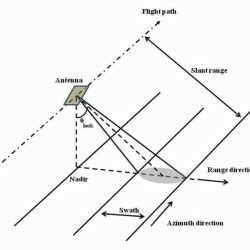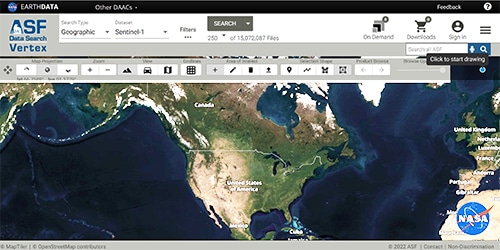Also see Fundamentals of SAR Media Resources
How Does it Work?
A synthetic aperture radar (SAR) is an active sensor that first transmits microwave signals and then receives back the signals that are returned, or backscattered, from the Earth’s surface.
Flight and Directional Terminology
The instrument measures the distance between the sensor and the point on the Earth’s surface where the signal is backscattered. This distance is the slant range (see illustration), which can be projected on the ground representing the ground range. The flight direction is also referred to as the along-track or azimuth direction, and the direction perpendicular to the flight path is the across-track or range direction. The angle between the direction the antenna is pointing, and the nadir is the look angle. The angle between the radar beam center and the normal to the local topography is the incidence angle. Both angles are sometimes used synonymously, which is only valid if the InSAR geometry is simplified, neglecting the Earth’s curvature and the local topography. Because the look angle of the sensor significantly affects the behavior of the backscatter, it is one of the main parameters determining the viewing geometry and the incidence angle of the backscattered signal. Depending on the characteristics of the illuminated terrain, areas of layover and shadow may occur in the imagery.
Wavelength and Effects
The wavelength of the sensor determines the penetration depth of the transmitted signal into the vegetation layer of the terrain surface. The longer the wavelength, the deeper the penetration can be, particularly in forests.
- The energy of an X-band sensor is mainly returned at the top layer of the canopies.
- Most of the L-band signal penetrates through the upper vegetation layer and is returned at the ground surface.
- The backscatter behavior of the C-band is less predictable. Due to volume scattering effects, the layer of backscattering is less determined and does not correspond directly to a terrain surface — neither the vegetation surface nor the ground surface.

Resolution and Speckle
The spatial resolution of the radar sensor defines the minimum separation between the measurements the sensor is able to discriminate and determines the amount of speckle introduced into the system. Speckle is a scattering phenomenon that arises because the spatial resolution of the sensor is not sufficient to resolve individual scatterers. Speckle can be reproduced if the acquisition conditions are identical, while noise is random in nature. Speckle is removed by multi-looking. The higher the spatial resolution of the sensor, the more objects on the ground can be discriminated. The term spatial resolution is often confused with pixel size, which is the spacing of the pixels in the azimuth and ground range direction after processing the data.



